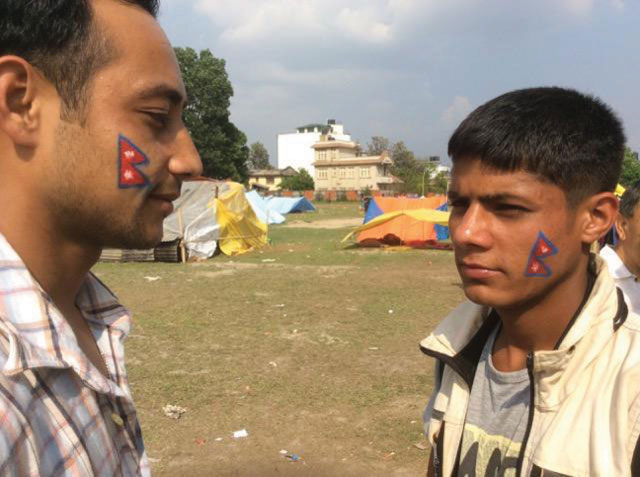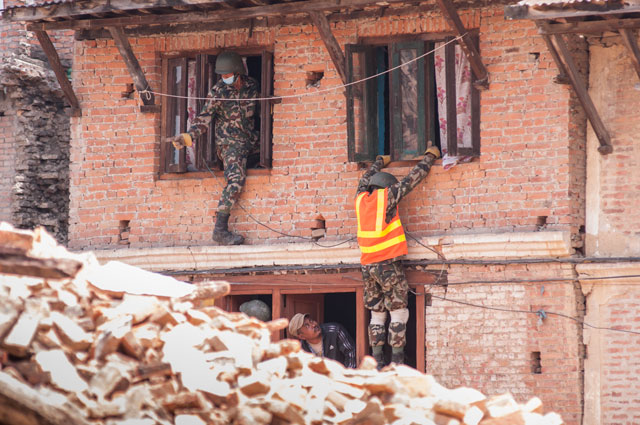What do writers do in a disaster? They write, and they read what others are writing. And they write more, true stories worth telling.
 For weeks after April 25 I searched the Internet and scoured social media to see what was being written about the Nepal Earthquake of 2015. It was an immense crisis with a large global reaction. While most stories described horrific scenes of devastation, many shared positive examples of help, hope, and optimism.
For weeks after April 25 I searched the Internet and scoured social media to see what was being written about the Nepal Earthquake of 2015. It was an immense crisis with a large global reaction. While most stories described horrific scenes of devastation, many shared positive examples of help, hope, and optimism.
Among first person accounts as the catastrophe unfolded were stories of • brave and daring efforts of First Responders (police, army, friends and neighbors) searching for survivors; • personal stories of distress and relief, of grief and joy, and moving examples of selfless altruism; • a profound collective anguish at the collapse of so many ancient monuments and religious edifices, and promises to help restore them; • massive outpourings of assistance by local, national and international NGOs and relief agencies; and • a mix of both criticism and praise for government bodies and some leaders during the crisis. And the list goes on.
Several important points come up. One is that we writers must use our journalistic talents to research and write about crisis in calm but strong and dispassionate words and verbal imagery. Disasters test our skills and abilities, and our sensibilities, just as they do for doctors and nurses, emergency first responders, structural engineers, police and firefighters, relief workers, and (not least) elected leaders.
 At first, the international media focused on Kathmandu Valley, and on the fate of Sherpas and climbers at Mount Everest. Then they turned to the devastation and despair witnessed in the worst affected villages of Gorkha (the epicenter), Rasuwa and Sindhupalchok districts, and after the second big one from Dolakha east to Khumbu.
At first, the international media focused on Kathmandu Valley, and on the fate of Sherpas and climbers at Mount Everest. Then they turned to the devastation and despair witnessed in the worst affected villages of Gorkha (the epicenter), Rasuwa and Sindhupalchok districts, and after the second big one from Dolakha east to Khumbu.
Disasters are a challenge. Our first instincts and reactions are to help family, friends and neighbors survive and recover. But we writers also feel compelled to share what’s happening. Anyone can write angry accounts about poor leadership, and a litany of graft, greed and corruption during the disaster, but we have a more important task. We must write the positive stories that should be told, stories of hope and resilience, of people addressing the crisis with a positive spirit and unselfish interest over the long term. This is not a one day, or one week crisis; the aftermath of the Nepal Earthquake will shake Nepal for years to come.
Opportunity, Resilience and Hope
Naresh Koirala, writing in Setopati, Nepal’s digital newspaper a week after the big quake, notes that the Chinese character for ‘crisis’ includes a character for ‘opportunity’. “Can we turn this crisis into an opportunity?” he asks, and if so, “How do we do it?”
Fortunately, humans are endowed with an innate biological drive to triumph over adversity. It’s called resilience, and it implies an ability to recover readily or quickly, to ‘bounce back’ from misfortune or adversity. Resilience is revealed in remarkable buoyancy, strength and hope among survivors in the midst of unspeakable destruction and tragedy. Reactions to the opportunities that emerge suggest the themes that we must reveal and record.
We find them in the unselfish help that neighbors give to those who have suffered the most, regardless of social status; when the well-off help the most poor; where those who have suffered the least help total strangers who have suffered more; and how strong willed individuals and groups rise above the crisis to help each other rebuild from the ground up.
The positive stories coming out of crises are our opportunities for sharing, understanding, participation and contribution. What we see and say about resilience helps victims of tragedy put their shattered lives back together in new ways. Such stories also help others realize the power that they themselves possess.
A Journalism of Hope
Some publications focus on hope in times of helplessness. For example, The Emergency, an online journal, is dedicated “to unearth the unreported, unrecorded incidents for the larger world. Not the usual journalism, but journalism of hope.” Several Nepal earthquake stories are posted at theemergency.org.
At the same time many small Nepal-based NGOs have collected tons of relief supplies – tents, tarps, food, medicine, and housing materials – from various sources, then marshaled volunteers and vehicles to deliver them quickly to devastated communities. There are stories of Nepalese NGOs like the Gorkha Foundation that have focused relief work in the most devastated communities at the epicenters. In normal times, the Gorkha Foundation supports self-help development solutions to local challenges in Gorkha District. Now in its ‘disaster response mode’, the foundation’s relief work has been widely broadcast in text and photos on facebook and the web.
Stories of many such relief efforts quickly spread across the Internet. One appeared on May 14 at npr.org describing concerned citizens “setting up new groups to fill the void, including one that’s run out of a bed-and-breakfast in Kathmandu’s twin city of Patan.” Writer Donatella Lorch, in ‘Nepal’s Peaceful Revolution: Citizens Rise Up To Aid Mountain Villages’, highlights the helpful efforts of the quickly organized Himalayan Disaster Relief Volunteer Group (a.k.a. the ‘Yellow House Group’). Their emergency response has been read worldwide. In an article at wired.com entitled ‘Nepal’s aid system is broken, so these lifesavers hacked it’, writer Abe Streep describes the work of this group as “scrappy, relying on local knowledge, Facebook or word-of mouth organizing, and cash donations.”
A particularly unique account appeared in a USA newspaper in mid-May entitled ‘Oregon Firefighters in Nepal to Reopen Medical Clinic’. It was posted by Hannah Leone on May 15 at oregonlive.com, the website of the Portland Oregonian. It describes the Portland Fire and Rescue group, including medical personnel, going to Nepal in the wake of the quake. What’s unusual is the source: a series of short tweets by team members from a remote village near the Gorkha epicenter sent on Twitter, some of which awoke Ms Leone in the middle of the night Oregon time. Putting them together, she wove a compelling story of the Portland team attending to medical emergencies and helping villagers rebuild a collapsed health post.
And, before returning to Oregon, the firefighters trained Pokhara city firefighters in advanced fire hose handling, skills that were quickly put to work on a fire that broke out two hours later. Such stories bode well for continued resilience and hope among the Nepalese, and have reassured readers from afar that Nepal is firmly on the mend.
Photographers and photojournalists are also on track, as illustrated in observations by the Kathmandu-based photographer, Tom Kelly. In ‘Resiliency Post Earthquake Nepal’, Kelly defines the “resiliency photographer” as one whose responsibility it is “to help the subject recognize and see their own strengths and resources, no matter how challenging the circumstances” (www.thomaslkellyphotos.com/REPORTAGE/Resilency-After-Earthquake).
Immediately after the April 25 quake, Matthieu Ricard of Kathmandu’s Shechen monastery posted a story in The Huffington Post (online) describing people at the moment of greatest crisis helping one another with calm and disciplined altruism. “The kind of behavior... observed in Kathmandu and other affected areas,” he noted, “is consistent with the conclusions of systematic studies conducted about the behavior of people during major catastrophes: altruism and pro-social behavior, community resilience, and unity usually prevail. Most disaster victims take the initiative to help themselves and others. A large part of the initial sheltering, feeding, relief, rescue, and transport of victims to hospitals is being carried out by relatives, neighbors, passersby, and other survivors.”
Responsibility and Ethics
The Society of Professional Journalists (SPJ; at spj.org) promotes these general ethical guidelines for reporters and writers: • ‘Seek Truth and Report It’ (for example: be honest, accurate, fair and courageous in gathering, reporting and interpreting information...), • ‘Minimize Harm’ (show compassion; be sensitive in interviews and while taking photos; be cautious and judicious...), • ‘Act Independently’ (avoid conflicts of interest; be vigilant and courageous about holding those with power accountable; avoid association with special interest groups...), and • ‘Be Accountable’ (expose unethical practices of journalists, the news media and others; and avoid mistakes and correct them...).
The SPJ ethical codes are enhanced for disaster writing in a small booklet called ‘Tragedies and Journalists’ posted by the Dart Center for Journalism & Trauma at Columbia University (dartcenter.org) advising writers to: • treat victims with respect, dignity and privacy; • seek ‘first person’ accounts that reveal altruism and illustrate deeper meaning and experience; • document the positive, such as specific acts of kindness; and • don’t stop writing when the mainstream media turns away, but continue reporting throughout the longer recovery process. Rehabilitation and rebuilding will continue for a long time and writers must go on identifying opportunity and bolstering resilience. Positive journalism gives hope and fortifies the national rebirth process.
‘Nepal’s Finest’
After seeing the spontaneous relief efforts and generous expressions of humanity by so many Nepalese, Tashi Sherpa wrote one of the most powerful statements about hope and rebirth in Nepal, in the May 6 issue of The Seattle Times (seattletimes.com/opinion). “Even in the grim aftermath of this disaster,” he writes, “hope shines through. There is a new age in Nepal. A grass-roots movement is taking place among its young, educated and talented people...”
“Nepal’s spring of chance is happening right now,” he goes on. “In the immediate aftermath of this calamity, the one thing that stood out was the instant compassion and a can-do resourcefulness of a new force in our country. The pushcart vendor who gave all of his fruit to the tent-city occupants, the soldiers and police constables, the selfless nurses and doctors working without rest, the thousands of volunteers braving the odds: They are Nepal’s finest, all working tirelessly through the nights to rescue those trapped under rubble. These are the mental notes I take away with me so that I can proudly tell of what happened when the great earthquake came. Nepal will rise.”
We writers must also rise – to the challenge of continuing to find and tell positive stories of resilience, rebirth and renewal for as long as the crisis goes on...
“People are proud and not defeated (as) they began immediately to sort through the rubble and save materials to rebuild. But their losses are tremendous. And now that Nepal is no longer on the front pages of the news people will continue to pull their lives back together. A very long time and a lot of work to do... Don’t forget the people of Nepal.”– Bill Hansen (former Nepal Peace Corps Volunteer) in an email from Kathmandu in May.
“The Nepali people are resilient and I have no doubt they’ll recover and continue moving forward.”– Heather Knight, writing as ‘RenegadePilgrim’ on Facebook.










